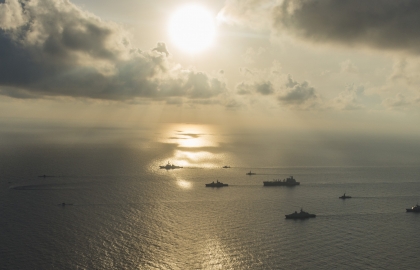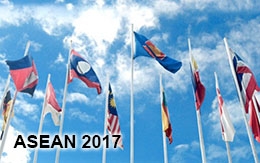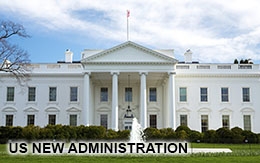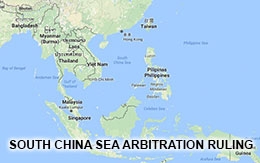Why ‘Good Order’ at Sea Matters
As disputes have escalated into tit-for-tat actions at South China Sea and East Sea, including naval posturing and provocative land reclamation, regional states have sought to enhance ‘good order' by attempting to formalize a nautical ‘code of conduct’. Yet, strategic analysts have proffered differing interpretations of maritime ‘good order’
By Abhijit Singh
January 10, 2018

Abstract: Recent developments in littoral-Asia underscore the need for nautical ‘good order’. The maritime environment in the Asia-Pacific has deteriorated sharply in recent years amid growing rancor over sovereignty claims in the South China Sea and the East Sea. As disputes have escalated into tit-for-tat actions at sea, including naval posturing and provocative land reclamation, regional states have sought to enhance ‘good order' by attempting to formalize a nautical ‘code of conduct’. Yet, strategic analysts have proffered differing interpretations of maritime ‘good order’. Some view ‘order’ as a metaphor for maritime cooperation, emphasizing the need for consensus in regional governance. Others see it as a product of ethical maritime conduct, meant to create mutual confidence through principled behavior at sea. Aggressive maneuvers such as those by the People’s Liberation Army Navy in the South China Sea, its proponents aver, hurt the cause of rules-based maritime security.
Introduction
Still, regional maritime forces have maintained a modicum of collaboration to secure vulnerable spaces in Southeast Asia where growing non-traditional security challenges continue to imperil security. Despite growing strategic rivalries across the Asia Pacific, collective security in the regional commons has continued as earlier. The emphasis on collaborative constabulary is the result of the growing number of ‘hybrid’ threats and grey-zone challenges in the regional littorals, characterized by a blurring of lines between traditional challenges and sub-conventional threats.[1] Southeast Asia’s distinctive maritime geography makes it highly susceptible to disruption by regional maritime forces, non-state religious radical elements, as well as state-backed militia forces. To counter these complex challenges, maritime forces have sought to raise their cooperation in the contested littorals.
Against the backdrop of growing asymmetric challenges, Asia-Pacific states have underlined the need for maritime ‘good order’, and the collective defense of the nautical commons.[2] While Southeast Asia’s maritime geopolitics remains in a state of flux --fueled by growing rancor over historical and legal claims to sovereignty in the South China Sea – regional analysts point to the need to prevent tit-for-tat actions at sea, including naval skirmishes and provocative land reclamation projects. Yet, regional states proffer differing interpretations of maritime ‘good order’. Notwithstanding their agreement on the need for greater trust-building measures, they differ on the specifics of how it must be achieved.
Defining Good Order
For some maritime analysts, the essence of “good order at sea” is a mechanism through which regional Navies and Coast Guards collectively shape the maritime environment for the robust defense of shared maritime interests. In their telling, the aim of naval good order is not only the security of oil and resources shipments, but also the development of regional norms that help in environmental preservation and the development of marine resources, in accordance with international law.[3]
The ‘pragmatists’ emphasize “cooperation” between countries and the importance of consensus in regional governance. Its proponents advocate greater synergy in tacking ‘tame’ irregular threats, whist avoiding the discussion of ‘wicked’ traditional threats.[4] They also claim that Asia’s security order must exclude extra-regional states whose interests are not directly impacted by insecurity in the littorals.[5] More importantly, these thinkers believe ‘good order’ can be achieved by accomplishing lower order goals: preserving marine habitats; fighting pirates and sea robbers; countering the illegal movement of people and goods; combating illegal, unregulated and unreported (IUU) fishing; and dealing with climate change problems, likely to impact the lives of populations across the Asia Pacific.
Those that see ‘naval good order’ in predominantly cooperative terms, however, tend to deemphasize regional territorial disputes. Sam Bateman, a leading proponent of this school, for instance, sees the overt focus on Chinese assertiveness vis-à-vis territorial claims in the South China Sea, as counter-productive in bringing about greater maritime order. The Australian academic and author raises doubts about the effectiveness of the Arbitral Tribunal’s 2016 ruling on the South China Sea, where the court’s emphasis on EEZ jurisdiction, says Bateman, has reinforced a nationalistic attitude among littoral states. Upholding ‘fences in the sea’, rather than recognizing that maritime boundaries are not ends in themselves, he adds, is severely counter-productive.[6] Indeed, if maritime boundaries in fact are just a means of effectively managing maritime space – a basic objective of all the littoral states and an obligation under Part IX of the United Nations Convention on the Law of the Sea (UNCLOS) -- then it is incumbent on all states to cooperate in semi-enclosed seas like the South China Sea.
There is, however, another strand of maritime thought that views ‘good order’ as the outcome of a process that prioritizes orderly maritime conduct. Navies, proponents suggest, create confidence in each other through orderly and collaborative interactions at sea.[7] Aggressive naval maneuvers such as those by the People’s Liberation Army (PLA) Navy in the South China Sea, however, do not produce much confidence, and mere avoidance of conflict, they add, is not good enough.[8] Indeed, Beijing has spent the past two years building artificial islands in the South China Sea and more recently, extending the reach of its territorial claims by constructing aircraft runways and erecting military facilities such as artillery batteries and radar stations. As late as July 2017, Chinese Coast Guard ships (aided by militia boats) were seen patrolling Scarborough Shoal, in the Philippines’ Exclusive Economic Zone (EEZ). Restrictions imposed by the Chinese maritime forces over Filipino fishermen near Sandy Cay close to the coast of Philippines, caused some concern in Manila and other regional capitals.[9] A section of maritime community believes that as long as China stays aggressive and uncaring of the concerns of its partner states, peace, peace will not be enduring.
To be sure, maritime analysts on either side of the ‘naval good order’ divide, broadly concur that cooperation is both a necessity and an obligation for maritime forces in the Asian littorals. While their ideas about creating greater trust between regional stakeholders, and collaborative synergies in areas such as maritime security, fisheries management, environmental protection and marine scientific research vary significantly, they broadly agree that many contentious aspects have been politicized. Creating strategic empathy, they collectively affirm, requires a political process.
The Indian Experience
For India’s policy elite, New Delhi’s own conduct in the Indian Ocean sets a fit example of ‘maritime good order' -- both in military operational and political terms. While the Indian navy has desisted from any over power projection in the Indian Ocean Region IOR, Delhi has also been remarkably accommodating of the claims and concerns of its regional neighbors.[10] In July 2014, India accepted a U.N verdict on a long-standing and fraught, maritime boundary dispute with Bangladesh, even though the verdict was in Dhaka’s favor, more than tripling the size of Bangladesh’s EEZ in the Bay of Bengal. Not only did India gracefully accept the verdict, it pledged to work with Dhaka to enhance maritime security and development in the region. However, New Delhi has also placed new emphasis on freedom of navigation, frequently alluding to the importance open and free sea-lanes in diplomatic statements and public declarations, while obliquely chastising China for its expansionist behavior.
Indian watchers, like many Southeast Asian observers, believe China’s hostility toward the international maritime legal regime serves Beijing’s global interests. More than Beijing’s tone on the issue, they note, it is the substance of China’s discourse that is causing alarm. Chinese officials’ growing tendency to privilege self-defined “historic rights” over international law, the rhetoric centered on China’s civilizational exceptionalism, raises difficult questions over the nature of Beijing’s rapport with the existing international order. Even the stationing of military assets and hardened infrastructure on some of China’s most recently redeveloped land features is a matter of worry for Indian observers who say the facilities could in time be used to facilitate the projection of Chinese maritime forces in the Indian Ocean.[11]
Code of Conduct Discussions
During the Association of Southeast Asian Nations (ASEAN) summit in Manila in August 2017, ASEAN countries and China endorsed a framework on the code of conduct (COC) in the South China Sea. For many observers, however, this was no meaningful breakthrough, as it sought to do precious little to regulate China’s conduct in the Southeast Asian commons. First, commentators point out, Beijing’s insistence for a new “cooling down” period in the South China Sea seemed disingenuous (an attempt to buy some more time in deliberations). China’s detractors say, the move is consistent with Beijing’s tendency to “calibrate its maritime assertiveness between coercive actions to enforce its extensive claims and periods of charm to consolidate gains made and to manage perceived losses in interactions with ASEAN states, major powers, and the international community”.[12] Second, the new code is non-binding and un-enforceable, which means China will feel no pressure to abide by its tenets, Not surprisingly skeptics see the present case as a replay of negotiations on the non-binding Declaration on the Conduct of Parties (DOC) in 2002 when Beijing agreed to join only after executing the first seizure of a Mischief Reef in 1995.
Many ASEAN states in fact believe Beijing will continue to acquire the capabilities to undertake calibrated actions for enforcing its extensive (and unlawful) claims in the South China Sea at others’ expense while not entirely alienating neighboring states and jeopardizing its rise. China’s construction of military facilities on the Spratly Islands has continued, along with other familiar sorts of behavior such as the coercion of other claimant states (most notably Vietnam on energy exploitation) and pressure on other regional and extra-regional states not to “interfere.” Meanwhile, Chinese leaders continue to restate, as President Xi Jinping did during his speech at the 90th anniversary of the PLA that China will not cede an inch of territory, a rather unhelpful stance as it only exaggerates nationalist sentiment at home and makes agreements like joint development harder to strike abroad.[13]
Even if China concurs with a binding-COC, maritime analysts say, Beijing is unlikely to agree to a freeze on island building, reclamation, and militarization. Any movement forward, they point out, will materialize only after the PLA has established control over the South China Sea. This would need strong steps like reclaiming Scarborough Shoal and developing the capabilities for an effective, enforceable (and perhaps undeclared) air defense identification zone (ADIZ). In sum, China would only accede to the COC once it achieves its objectives in the South China Sea. Sadly, by that time, a COC will not really matter much.
Need for a Global Maritime Order
In establishing regionally acceptable rules, one must acknowledge that the South China Sea dispute is essentially ideological in nature. China’s competition with the US and its allies is based mainly on traditional misgivings, misperceptions, miscommunication, and an action-reaction dynamic. Beijing’s vociferous opposition to last year’s Arbitral Tribunal ruling demonstrated that the roots of these tensions go deeper. Long-standing observers of China point to the regime’s intellectual roots, and to the Marxist vision of international law, which they note, is as an instrument for the exertion of power, to be shaped, utilized, or discarded at will.[14]
But this also means that China will not abide by an objective set of norms that do not promote its interests. For many observers, Beijing’s maritime approach underlines a revisionism that is irreconcilably at odds with the core norms of good maritime conduct that undergirds the global order. Pacific democracies view the order as indispensable, but seek the support of smaller regional states in maintaining it. Indeed, for many western and East Asian commentators, China’s assault on freedom of navigation in the maritime domain looks set to morph into an increasingly bitter legal and ideological struggle for the future of the global commons. There is already a substantial body of Chinese scholarly literature which seeks to assert the China’s vertical sovereignty over the portions of outer space directly above China’s terrestrial borders.
Unfortunately, the United States currently appears somewhat isolated in its stalwart defense of freedom of navigation.[15] In fact, barring a few exceptions such as Japan and France, most strong maritime powers have been unwilling to risk Beijing’s ire by vigorously defending freedom of navigation in the contested waters of the South China Sea. Meanwhile, Chinese diplomats have grown ever more adept at engineering intra-regional divisions, whether within Southeast Asia or the European Union. The tepid international response and the Association of Southeast Asian Nations’ (ASEAN) growing timidity in the face of the China’s violations are causes for serious concern, as they run the risk of reinforcing China’s narrative that international law is merely an American tool.
One of the core tasks ASEAN states will be to demonstrate why this is not the case, and how Southeast Asia can work with even countries such as India, that lie outside the South China Sea but still espouses solidarity with ASEAN, and support for high-seas freedoms. Since the law of the sea is an essential public good, ASEAN states would like to see the US and its allies continue with freedom of navigation patrols (FONOPS), though it will need to be a nuanced operation, and a lot less publicized.[16] Efforts will be needed to enhance and further institutionalize sub-regional naval groupings of fellow defenders of the global commons, with an emphasis on regular joint exercises in the South and East China Seas—in the vein of the recent joint drills involving Japanese, French, U.S., and British military forces in the East China Sea.
The Way Forward
What then might produce greater ‘order’ in the Southeast Asian littorals? The answer lies in raising the efficacy of measures by ASEAN and China to create operational coordination and political trust. On the one hand, regional navies and Coast Guard forces will need to start cooperating unconditionally. Increasing shipping traffic in the Southeast Asia, pressures on marine resources, environmental degradations and the need to avoid a ‘tragedy of the commons’ makes it incumbent upon regional states to collaborate. With over a vast majority of coral habitats in a critical state of degradation, ASEAN states will need to move expeditiously to get their acts in order. Most fish stocks in the sea are either fully exploited or over-exploited, particularly in the western part of the sea. Even as the marine environment and sustainable development of living resources has been jeopardized by political mistrust, ASEAN will need to make an effective start.
In the main, however, ASEAN states will need to cooperate with regional partners in effectively managing disputes in the South China Sea. This might need fresh negotiations and the building of functional cooperation in areas such as marine scientific research, fisheries management, protecting and preserving the marine environment, maritime law enforcement, and search and rescue (SAR). Regional states will also need to stop acting in largely their own self-interest. Rather than adopt maximalist positions on territorial matters, nations will need to strive for ‘win-win’ outcomes achieved through cooperation.
For regional maritime forces, there is a lesson to be learnt from anti-piracy operations off the coast of Somalia. The deployment is in the common interests of regional countries and does contribute to the building of strategic trust. Humanitarian assistance, in particular, is a ‘low-hanging fruit’ that does not require a high degree of trust for navies to cooperate with competitors. There are examples where the US Navy and the PLAN came together for humanitarian purposes in Southeast Asia. Building trust will need states to stop being provocative at sea and desist from making statements that will add to distrust and frustrate cooperation. In particular, China and the United States will need to develop a modus vivendi in which both countries can work constructively with ASEAN. There is a growing belief that even cooperation on softer security issues, such as fisheries management and marine environmental management -- seen as confidence-building engagement – is not possible without trust.
ASEAN and China will need to look for ways to forge greater trust. It is a matter of concern that ‘soft’ issues of maritime cooperation have been ‘securitized’ in the manner of traditional security threats. This securitization contributes to the ‘politicization’ of maritime cooperation, even for activities that are obligations of the littoral countries. This restrictive security approach leads to greater strategic suspicion, and a failure of collaborative endeavors. What the region needs is a model approach, where multiple partners can come together in deliberate and thoughtful ways that enhance security and preserve national interests. Maritime ‘good order’, if practiced well, can potentially alter the dynamics of security cooperation. But states must be honest enough to acknowledge that their flawed approaches to security need correction.
That is also the hallmark of a ‘principled’ and norms-based security network, dependent primarily on strategic trust and political goodwill.
Abhijit Singh is a Senior Fellow and Head, Maritime Policy Initiative at the Observer Research Foundation, New Delhi, India .
The paper was presented at the Conference: "Navigating towards the free and open seas of Asia: The role of international law in maintaining good order at sea," 12 September 2017, Hanoi, Vietnam. This conference is co-organized by Embassies of the UK and Japan in Vietnam and the Diplomatic Academy of Vietnam (DAV).
Click here for pdf file.
¯¯¯¯¯¯¯¯¯¯¯¯¯
[1] Michael Green, Kathleen Hicks, Zack Cooper, Countering Coercion in Maritime Asia: The Theory and Practice of Gray Zone, Centre for Strategic and International Studies (CSIS), May 2017, Rhode Island, Washington DC, P-23
[2] “Good Order at Sea in Southeast Asia”, Rajaratnam School of International Studies (RSIS) Policy Paper, July 2012
[3] Sam Bateman, "Good Order At Sea in the South China Sea", in Shicun Wu and KeyuanZou (eds), Maritime Security in the South China Sea: Regional Implications and International Cooperation, Ch.2, pp. 16-36, Ashgate, England, 2009.
[4] Sam Bateman, “Solving the ‘Wicked Problems’ of Maritime Security: Are Regional Forums Up to the Task?”, Contemporary Southeast Asia, vol. 33, no. 1, April 2011
[5] Huang, V, "Building Maritime Security in Southeast Asia: Outsiders Not Welcome?" Naval War College Review, Vol. 61, pp. 96-98, Naval War College, Newport, 2008
[6] Sam Bateman, “Building Cooperation for Managing the South China Sea Without Strategic Trust”, Journal of Asia & the Pacific Policy Studies, vol. 4, no. 2, April 2017, pp. 251–259
[7] John f. Bradford, Greg R Adams and Sean Quirk, “New Multilateralism For Maritime Southeast Asia: More Value Per Carat” War on the Rocks, September 5, 2017
[8] Jonathan Odom, “Merely Avoiding Conflict in the South China Sea Is Not Good Enough”, The Diplomat, June 24, 2017 at http://thediplomat.com/2017/06/merely-avoiding-conflict-in-the-south-china-sea-is-not-good-enough/
[9] Ankit Panda, “South China Sea: A Chinese 'Invasion' Near the Philippines' Pagasa Island in the Spratlys?”, The Diplomat, August 22, 2017 at https://thediplomat.com/2017/08/south-china-sea-a-chinese-invasion-near-the-philippines-pag-asa-island-in-the-spratlys/
[10] Nethra Singhi, Viraj Tuli, “India’s Maritime Cooperation with Bangladesh: Challenges and Opportunities”, Centre for Land and Warfare Studies, June 29, 2017, at http://www.claws.in/1762/india%E2%80%99s-maritime-cooperation-with-bangladesh-challenges-and-opportunities-nethra-singhi.html
[11] Brahma Chellaney, “Democracies must rally to curb China's Indian Ocean ambitions”, Nikkei Asian Review, October 12, 2017, at http://indianexpress.com/article/opinion/columns/indias-political-and-security-establishment-needs-a-strategy-in-light-of-chinas-naval-expansion-4626796/
[12] Prashanth Parameswaran, “Will a China-ASEAN South China Sea Code of Conduct Really Matter?”, The Diplomat, August 5, 2017, at http://thediplomat.com/2017/08/will-a-china-asean-south-china-sea-code-of-conduct-really-matter/
[13] “China will never give up an inch of territory, says Xi Jinping”, The Australian, August 2, 2017, at http://www.theaustralian.com.au/news/world/china-will-never-give-up-an-inch-of-territory-says-xi-jinping/news-story/200b236f0e9e8ffe3a234cd7985c0a6d
[14] Jennifer Lind, “Asia's Other Revisionist Power”, Foreign Affairs, April 2017, at https://www.foreignaffairs.com/articles/asia/2017-02-13/asias-other-revisionist-power
[15] Hugh White, China would call America’s bluff in the South China Sea, The Lowy Interpreter, July 2017, at https://www.realcleardefense.com/articles/2017/07/21/china_would_call_americas_bluff_in_the_south_china_sea_111862.html
[16] Brendan S. Mulvaney, “The Unintended Consequences of the US Freedom of Navigation Operations in the South China Sea”, The Diplomat, November 2015, at http://thediplomat.com/2015/11/the-unintended-consequences-of-the-us-freedom-of-navigation-operations-in-the-south-china-sea/
Comments (0)
Same category
© 2016 Maritime Issues










